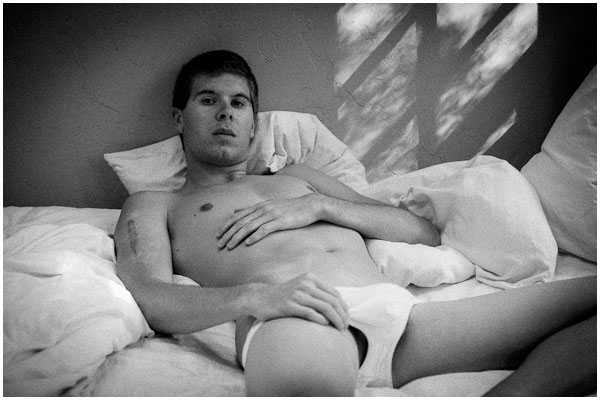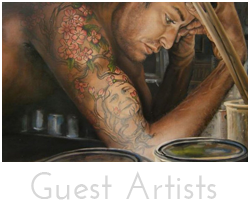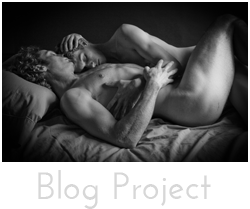 I was looking though Facebook last night and some black & white images caught my eyes that were rather stunning. Soon I was in a fascinating gallery of images that looked like they had actually been shot on film and then printed. I shot the photographer Russ Osterweil a message asking if indeed he was still shooting and processing film. We began to chat for an hour or so and it turns out we are both very much on the same path in our process. He too began in the darkroom with film, processing and printing his own black and white. There was defiantly a distinctive difference between the old film and the new digital and I was suddenly taken back to a time when I was first becoming a photographer. What an amazing process it has been, both then and now; though the processes are not remotely related they have become two distinctive approaches that still get us to the same end. In the old days (film) you had so many choices in your approach to crating an image. Every film had a distinctive grain structure. For those of you in the modern area film was imbedded with tiny granules of silver halide that reacted to light when it was exposed. You couldn’t see it until the film was chemically processed. The more sensitive the film was to light, the bigger the granules became making it faster to expose it to less light. Conversely the smaller the granule the brighter the exposure could be, such as mid-day, full sun. Thus creating a distinctive pattern in the film known as grain. With the modern area the image is read on a sensor that is completely devoid of grain; there is a flatness to it where the tone is all the same. The comparable equivalent would be pixels and the pixelizaton has become so fine that it’s really no longer discernible to the eye. What Russ has been doing it scanning those old negatives and working with them to create discernable images that still maintain the integrity of the original intention with which he shot them years back. It was a process I have tired to work with but have not been patient enough to fully explore, though I have cases and cases of images I would love to go back and rework, so I was trying to pick his brain on how the process could actually work his response was “Yes. There is a learning curve there for sure. You are dealing with grain AND pixilation. Pixilated grain, as it were. Tends to be very contrasty. Just gotta do it and experiment.” Looking through his portfolio there was such an honest poetry to the images that I began to admire. We began to talk about how similar our works were and I began recognize that many of the images that become most fascinating he was presenting in this new Facebook portfolio where actually images I had always rejected from my own work and always excluded printing. There was such a raw edge to the stuff I photographed in the beginning that I totally love in all his current images. “I see such poetry in the essence of moments captured in your work, that I normally would have discarded at the time.” I am totally jacked now about reexamining my own old process. It seems that we as photographers have lost a great part of our archives what document the progression of our work when we made the leap to digital, because the old negatives are no longer so readily accessible. Yet it was probably the greatest means of growth. I still use heavily rely on these techniques I leaned in the beginning and have a greater understanding of the nuance of exposure curves and learning to manipulate the image in to my vision. In the beginning photography was a process that took hours to create one image, so much of the other stuff shot was ignored due to time limitations. When I first moved to digital I printed my images, scanned them and manipulated them on the computer, once I figured out where I needed to take the picture I would go back into the darkroom and print what I had quickly created in the digital world. Now I am content to say I have mastered the digital world as well and want to reverse the process and bring the old world into the new.
I was looking though Facebook last night and some black & white images caught my eyes that were rather stunning. Soon I was in a fascinating gallery of images that looked like they had actually been shot on film and then printed. I shot the photographer Russ Osterweil a message asking if indeed he was still shooting and processing film. We began to chat for an hour or so and it turns out we are both very much on the same path in our process. He too began in the darkroom with film, processing and printing his own black and white. There was defiantly a distinctive difference between the old film and the new digital and I was suddenly taken back to a time when I was first becoming a photographer. What an amazing process it has been, both then and now; though the processes are not remotely related they have become two distinctive approaches that still get us to the same end. In the old days (film) you had so many choices in your approach to crating an image. Every film had a distinctive grain structure. For those of you in the modern area film was imbedded with tiny granules of silver halide that reacted to light when it was exposed. You couldn’t see it until the film was chemically processed. The more sensitive the film was to light, the bigger the granules became making it faster to expose it to less light. Conversely the smaller the granule the brighter the exposure could be, such as mid-day, full sun. Thus creating a distinctive pattern in the film known as grain. With the modern area the image is read on a sensor that is completely devoid of grain; there is a flatness to it where the tone is all the same. The comparable equivalent would be pixels and the pixelizaton has become so fine that it’s really no longer discernible to the eye. What Russ has been doing it scanning those old negatives and working with them to create discernable images that still maintain the integrity of the original intention with which he shot them years back. It was a process I have tired to work with but have not been patient enough to fully explore, though I have cases and cases of images I would love to go back and rework, so I was trying to pick his brain on how the process could actually work his response was “Yes. There is a learning curve there for sure. You are dealing with grain AND pixilation. Pixilated grain, as it were. Tends to be very contrasty. Just gotta do it and experiment.” Looking through his portfolio there was such an honest poetry to the images that I began to admire. We began to talk about how similar our works were and I began recognize that many of the images that become most fascinating he was presenting in this new Facebook portfolio where actually images I had always rejected from my own work and always excluded printing. There was such a raw edge to the stuff I photographed in the beginning that I totally love in all his current images. “I see such poetry in the essence of moments captured in your work, that I normally would have discarded at the time.” I am totally jacked now about reexamining my own old process. It seems that we as photographers have lost a great part of our archives what document the progression of our work when we made the leap to digital, because the old negatives are no longer so readily accessible. Yet it was probably the greatest means of growth. I still use heavily rely on these techniques I leaned in the beginning and have a greater understanding of the nuance of exposure curves and learning to manipulate the image in to my vision. In the beginning photography was a process that took hours to create one image, so much of the other stuff shot was ignored due to time limitations. When I first moved to digital I printed my images, scanned them and manipulated them on the computer, once I figured out where I needed to take the picture I would go back into the darkroom and print what I had quickly created in the digital world. Now I am content to say I have mastered the digital world as well and want to reverse the process and bring the old world into the new.



